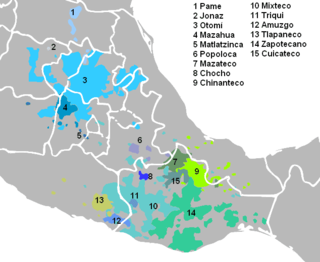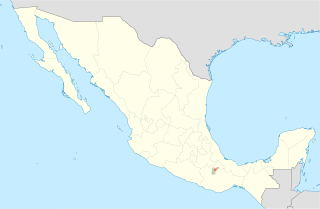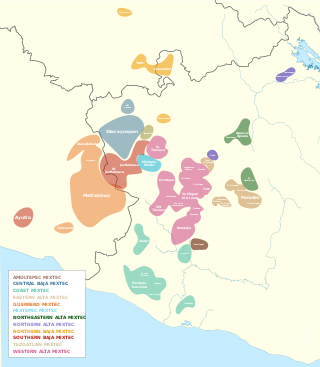
Mesoamerican languages are the languages indigenous to the Mesoamerican cultural area, which covers southern Mexico, all of Guatemala, Belize, El Salvador, and parts of Honduras, Nicaragua and Costa Rica. The area is characterized by extensive linguistic diversity containing several hundred different languages and seven major language families. Mesoamerica is also an area of high linguistic diffusion in that long-term interaction among speakers of different languages through several millennia has resulted in the convergence of certain linguistic traits across disparate language families. The Mesoamerican sprachbund is commonly referred to as the Mesoamerican Linguistic Area.

The Oto-Manguean or Otomanguean languages are a large family comprising several subfamilies of indigenous languages of the Americas. All of the Oto-Manguean languages that are now spoken are indigenous to Mexico, but the Manguean branch of the family, which is now extinct, was spoken as far south as Nicaragua and Costa Rica. Oto-Manguean is widely viewed as a proven language family.

The Mazatecan languages are a group of closely related indigenous languages spoken by some 200,000 people in the area known as the Sierra Mazateca, which is in the northern part of the state of Oaxaca in southern Mexico, as well as in adjacent areas of the states of Puebla and Veracruz.
Proto-Algonquian is the proto-language from which the various Algonquian languages are descended. It is generally estimated to have been spoken around 2,500 to 3,000 years ago, but there is less agreement on where it was spoken. The Algonquian family, which is a branch of the larger Algic language family, is usually divided into three subgroups: Eastern Algonquian, which is a genetic subgroup, and Central Algonquian and Plains Algonquian, both of which are areal groupings. In the historical linguistics of North America, Proto-Algonquian is one of the best studied, most thoroughly reconstructed proto-languages. It is descended from Proto-Algic.

Amuzgo is an Oto-Manguean language spoken in the Costa Chica region of the Mexican states of Guerrero and Oaxaca by about 60,000 speakers. Like other Oto-Manguean languages, Amuzgo is a tonal language. From syntactical point of view Amuzgo can be considered as an active language. The name Amuzgo is claimed to be a Nahuatl exonym but its meaning is shrouded in controversy; multiple proposals have been made, including 'moss-in'.
The Lakes Plain languages are a family of Papuan languages, spoken in the Lakes Plain of Indonesian New Guinea. They are notable for being heavily tonal and for their lack of nasal consonants.

The Mixtec languages belong to the Mixtecan group of the Oto-Manguean language family. Mixtec is spoken in Mexico and is closely related to Trique and Cuicatec. The varieties of Mixtec are spoken by over half a million people. Identifying how many Mixtec languages there are in this complex dialect continuum poses challenges at the level of linguistic theory. Depending on the criteria for distinguishing dialects from languages, there may be as few as a dozen or as many as fifty-three Mixtec languages.

The Oto-Pamean languages are a branch of the Oto-Manguean languages that includes languages of the Otomi-Mazahua, Matlatzinca, and Pamean language groups all of which are spoken in central Mexico. Like all Oto-Manguean languages, the Oto-Pamean languages are tonal languages, though most have relatively simple tone systems. Unlike many Oto-Manguean languages that tend towards an isolating typology, they are morphologically complex headmarking languages with complex systems of conjugational classes both for verbs and nouns, and in the Pamean languages there are highly complex patterns of suppletion.

The Triqui, or Trique, languages are a family of Oto-Manguean spoken by 30,000 Trique people of the Mexican states of Oaxaca and the state of Baja California in 2007. They are also spoken by 5,000 immigrants to the United States. Triqui languages belong to the Mixtecan branch together with the Mixtec languages and Cuicatec.

Cuicatec is an Oto-Manguean language spoken in Oaxaca, Mexico. It belongs to the Mixtecan branch together with the Mixtec languages and the Trique language. The Ethnologue lists two major dialects of Cuicatec: Tepeuxila Cuicatec and Teutila Cuicatec. Like other Oto-Manguean languages, Cuicatec is tonal.
Huave is a language isolate spoken by the indigenous Huave people on the Pacific coast of the Mexican state of Oaxaca. The language is spoken in four villages on the Isthmus of Tehuantepec, in the southeast of the state, by around 20,000 people.
The phonology of the Proto-Indo-European language (PIE) has been reconstructed by linguists, based on the similarities and differences among current and extinct Indo-European languages. Because PIE was not written, linguists must rely on the evidence of its earliest attested descendants, such as Hittite, Sanskrit, Ancient Greek, and Latin, to reconstruct its phonology.
Akpes (Àbèsàbèsì) is an endangered language of Nigeria. It is spoken by approximately 7,000 speakers in the North of Ondo State. The language is surrounded by several other languages of the Akoko area, where Yoruba is the lingua franca. Yoruba replaces Akpes in more and more informal domains and thus forwards a gradual shift from Akpes towards Yoruba. Akpes is generally attributed to the Volta-Congo Branch of the Niger-Congo phylum.
Proto-Tai is the reconstructed proto-language of all the Tai languages, including modern Lao, Shan, Tai Lü, Tai Dam, Ahom, Northern Thai, Standard Thai, Bouyei, and Zhuang. The Proto-Tai language is not directly attested by any surviving texts, but has been reconstructed using the comparative method.
Proto-Athabaskan is the reconstructed ancestor of the Athabaskan languages.

The internal classification of Mixtec is controversial. Many varieties are mutually unintelligible and by that criterion separate languages. In the 16th century, Spanish authorities recognized half a dozen lenguas comprising the Mixtec lengua. It is not clear to what extent these were distinct languages at the time. Regardless, the colonial disintegration of the Mixtec nation and resulting isolation of local communities led to the rapid diversification of local dialects into distinct languages. Below are some attempts at Mixtec classification by various scholars.

Robert E. Longacre was an American linguist and missionary who worked on the Triqui language and a text-based theory and method of discourse analysis. He is well known for his seminal studies of discourse structure, but he also made significant contributions in other linguistic areas, especially the historical linguistics of Mixtec, Trique, and other related languages. His PhD was at the University of Pennsylvania under Zellig Harris and Henry Hoenigswald. His 1955 dissertation on Proto-Mixtecan was the first extensive linguistic reconstruction in Mesoamerican languages. This was one of several SIL studies which helped to establish the Oto-Manguean language family as being comparable in time depth to Proto-Indo-European. His research on Trique was the first documented case of a language with five distinct levels of tone.
Proto-Bantu is the reconstructed common ancestor of the Bantu languages, a subgroup of the Southern Bantoid languages. It is thought to have originally been spoken in West/Central Africa in the area of what is now Cameroon. About 6,000 years ago, it split off from Proto-Southern Bantoid when the Bantu expansion began to the south and east. Two theories have been put forward about the way the languages expanded: one is that the Bantu-speaking people moved first to the Congo region and then a branch split off and moved to East Africa; the other is that the two groups split from the beginning, one moving to the Congo region, and the other to East Africa.
The Proto-Philippine language is a reconstructed ancestral proto-language of the Philippine languages, a proposed subgroup of the Austronesian languages which includes all languages within the Philippines as well as those within the northern portions of Sulawesi in Indonesia. Proto-Philippine is not directly attested to in any written work, but linguistic reconstruction by the comparative method has found regular similarities among languages that cannot be explained by coincidence or word-borrowing.
Proto-Sino-Tibetan (PST) is the linguistic reconstruction of the Sino-Tibetan proto-language and the common ancestor of all languages in it, including the Sinitic languages, the Tibetic languages, Yi, Bai, Burmese, Karen, Tangut, and Naga. Paul K. Benedict (1972) placed a particular emphasis on Old Chinese, Classical Tibetan, Jingpho, Written Burmese, Garo, and Mizo in his discussion of Proto-Sino-Tibetan.









